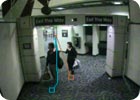
Intelligent video analysis is being pioneered at airports. Here cameras and software combine to detect and alarm to movement around planes on the ground.
Evolving intelligent video analysis, playing a growing role at global airports, shows how such new-age tools will help all types of enterprises with their security mission as well as increase operational efficiency.
Traditional security cameras, motion detectors and access control systems are just not enough to provide the robust security that airports today demand. A camera and recording platform alone, for example, offers passive monitoring optimized for post-event analysis but does little for security breach prevention; basic motion detection is capable of detecting movement but often generates false or “nuisance” alarms; and access control technology is beneficial for detecting if a door has been open, but not reliable for identifying all parties walking through it.
ENTER INTELLIGENT VIDEO ANALYSIS
Intelligent video analysis or what some call IVA is a surveillance technology that “watches” one or many video fields of view and detects, tracks, identifies and analyzes movements and behaviors of objects or people. By noting the presence of objects, absence of objects, and the location, direction and speed of movement, it detects movements or behaviors that deviate from specified “normal” parameters. IVA offers airports and other demanding environments a myriad of benefits ranging from securing critical assets and resources (human, financial, etc.) to reducing overall expenditures.For chief security officers, there are major benefits of intelligent video analysis.
ENHANCE PERIMETER PROTECTION
When it comes to perimeter protection, a handful of airports are leveraging just traditional ground and fence sensors as one layer of security to detect and thwart breaches in security. Even the best sensors, though, are limited by their inability to differentiate movement and provide increased response time. With IVA, subtle movement can be further qualified in terms of direction and speed, resulting in higher rates of desired detection and lower rates of false or nuisance alarms, compared to just one layer of security. More advanced systems can even direct PTZ cameras to follow an intruder.
Intelligent video analysis can automatically respond to preprogrammed conditions, such as patrons entering through an exit.
SEE AND PROCESS MORE THAN HUMANS CAN
With the ability to simultaneously receive, analyze and respond to inputs from many multiple cameras and sensors, IVA can “see” and process more than humans can in critical seconds. By combining different IVA algorithms from the same camera or from different cameras between them, as well as from other sensor inputs (such as radio frequency identification, fence sensors or access control), IVA provides more accurate threat assessments than the naked eye.AUTOMATE RESPONSES
Using pre-defined rules, an IVA platform may respond to different scenarios with a different set of pre-defined actions. For example, if it detects a person unlawfully approaching an airport terminal through a checkpoint exit lane, an integrated IVA platform may respond by playing an audio clip over a loudspeaker, warning the possible intruder to turn back. If it tracks the person moving into the terminal, it may react differently by sending pages to security officers, send a video clip to his mobile device, sound alarms or shut down gates and outer entrances, trapping the intruder.IMPROVE OPERATIONAL EFFICIENCY, REDUCE BOTTLENECKS
In addition to being an important security tool, IVA can also improve business processes and operational efficiency. For example, an advanced IVA system can be used to monitor the flow of vehicle traffic to identify areas of congestion that may have a negative impact on customer satisfaction. Within the airport terminal, IVA can be used to monitor crowds at check-point lanes, ticketing counters, etc. and alert operations managers to open more lanes or counters.Not only can this advanced technology automate first response to irregular conditions, it can also provide key information about the nature of the problem. As the technology matures and new standards are set, chief security officers can expect to see an increasing number of organizations adopt IVA as part of their overall security management strategy.
SIDEBAR: Benefits at a Glance
- Comply with federal guidelines and increasingly stringent security measurements
- Leverage the full potential and investment of existing cameras
- Automate response to “abnormal” conditions
- Dramatically improve safety and security
- Protect valuable assets
- Identify and reduce waiting times and bottlenecks
- Increase operational efficiency and productivity which, as a result, can reduce costs and improve customer service
SIDEBAR: Examples of IVA in Action
- Identify objects (e.g. luggage) left behind
- Capture suspicious behavior (e.g. loitering, tampering, etc.)
- Detect unlawful access to restricted areas
- Identify areas/patterns of over-crowding
- Monitor checkpoint exit lanes to prevent unlawful terminal entry

